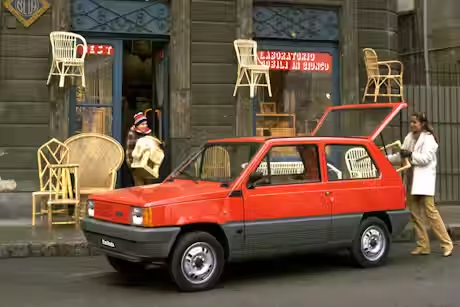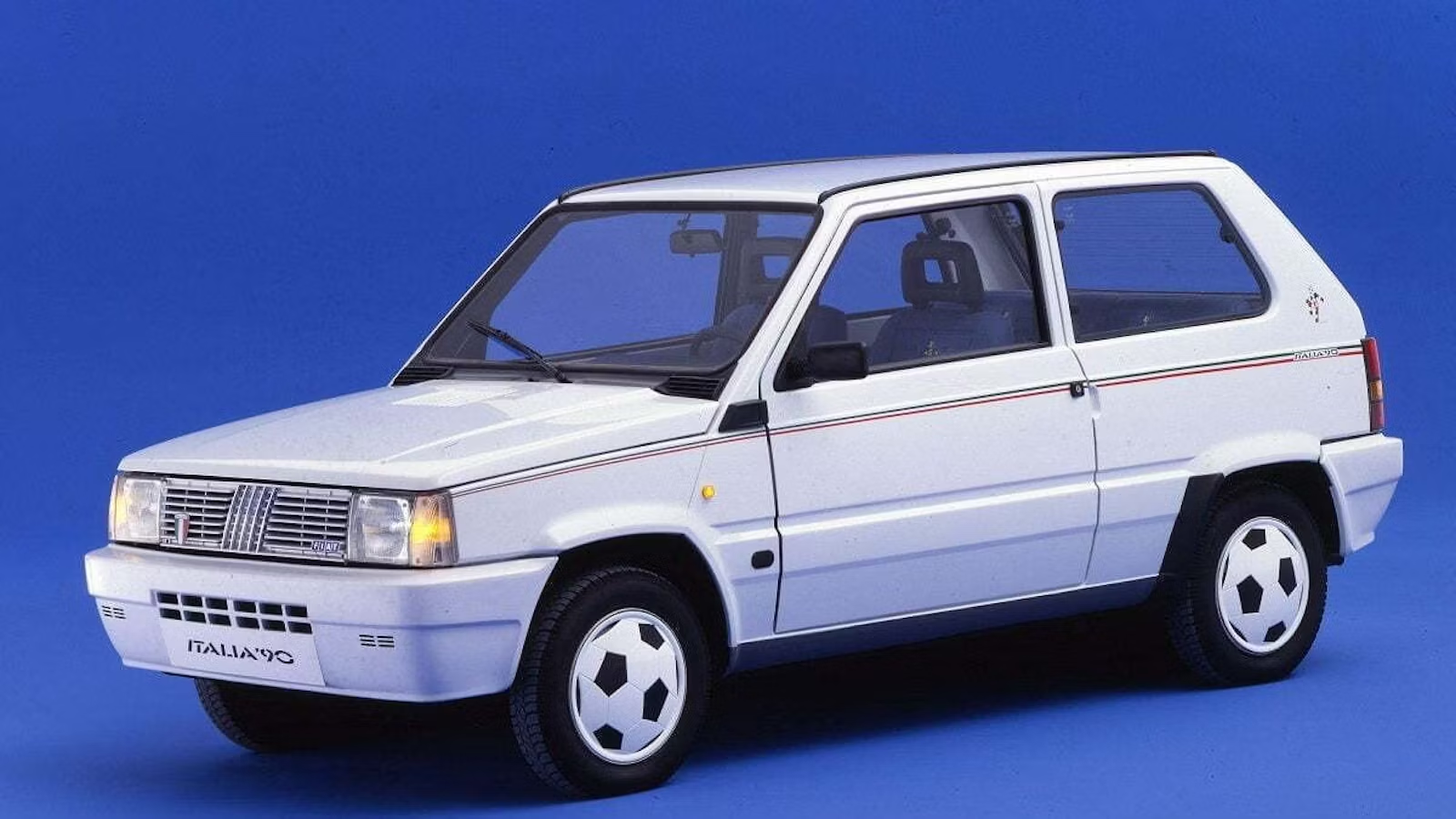RIP Fiat Panda: 12 things you never knew
August 21, 2024 by Tom Barnard

Car changing is a big deal
The Fiat Panda will no longer be sold in the UK. So we look back over the iconic car’s history and reveal 12 things you never knew about the Fiat Panda
The Panda is dead (for now). Here are a dozen Fiat Panda points you didn’t know…
If you notice Fiat fans wearing black and shedding a tear, it’s because they’ve heard the sad news. After 44 years, Fiat has announced that the Panda will no longer be imported to the UK.
It will be replaced in 2025 by a larger car, called the Grande Panda, (surely they missed a trick not calling it the Giant Panda?) which will be available with hybrid and all-electric powertrains. The price will also grow.
In an official statement, the company said: “In readiness for the launch of new Fiat Grande Panda, which will arrive in showrooms early in the new year, orders for current Fiat Panda in the UK will now be satisfied from existing stock.”

While it won’t be available to us Brits, the Panda will continue to be sold in the rest of Europe as the Fiat Pandina ‘special series’ until at least until 2027.
In honour of its passing (in the UK at least) here are our top 12 Panda facts.
1) It’s not a bear
The name Panda was chosen to pay homage to the Goddess Empanda, Roman patron of travellers. That didn’t stop the World Wildlife Fund objecting, as its logo was a panda. An agreement was reached after a large donation was made to the charity.

The original name for the car was going to be the Fiat Rustica – however it was felt this would not be ideal in some markets given the company’s reputation for corrosion.
The new Pandina moniker is the nickname Italians have always given the car, which is now being adopted officially.
2) Design pedigree
The Panda designer’s other work includes Bugattis, Ferraris, guns and a vinegar bottle: The first Panda was styled by Giorgetto Giugiaro. The Italian designer has some famous and exotic cars to his name, including the Bugatti EB112, De Tomaso Mangusta, DeLorean, Ferrari 250 GT Speciale Bertone, Lotus Esprit and Maserati Bora.
He also did some less glamourous cars which, like the Panda, sold in big numbers. The most famous is the Mk1 Volkswagen Golf, but his portfolio also includes the Hyundai Pony, FSO Polonez and Renault 21.

Away from the motor industry he designed everything from Marille pasta shapes to Modena Balsamic Vinegar bottles and Baretta firearms.
3) A-ha!
A Panda and an 80s pop star were instrumental in Norway’s EV revolution. Norway currently has the highest number of electric cars per capita of any country in the world. Around 90% of all new cars sold there are EVs.
This is due in no small part to Morten Harket (pictured below on the left), the lead singer of 1980s band A-ha, and his converted Fiat Panda.

In 1995 the singer bought the little Fiat which had been converted to run on electricity by a Swiss company. He then drove it around cities collecting fines for driving through tolls and bus lanes, and getting the car impounded. He would then buy it back and repeat the process.
The resulting publicity meant the authorities were forced to give concessions to electric cars and the rest is history.
4) Italia 90
The only factory convertible Pandas starred at the 1990 World Cup. Fiat sponsored the 1990 World Cup and to celebrate it produced the inevitable special edition Panda.

Besides featuring the logo of the tournament – a character called Ciao – and pinstripes in the colours of the Italian flag, the Italia 90’s most distinctive feature were wheelcovers which looked like footballs.
While these were sold across Europe, including 450 in the UK, the most special of the series were a dozen convertibles which drove onto the pitch before the matches. One was given to each of the Italian nation team too.
Once the England team crashed out of the tournament the dealers found little interest in the specials and the cars in stock were converted back to standard by peeling off the stickers and swapping the hubcaps.
5) Electric Panda
The Panda was the first mass-produced electric car from a major manufacturer. Electric cars might be common now, but in 1990 they were a real novelty. Fiat became the first mainstream car maker to produce and sell an EV with its Panda Elettra. The first version used weighty lead-acid batteries which took up the space usually used for the back seats. It had a range of 62 miles – but a top speed of only 43mph.

The petrol tank was kept to feed a small heater, so the Panda could not actually be classed as a zero-emissions vehicle. It also kept the regular 4-speed gearbox and clutch of the Panda, although drivers could just leave the car in third gear most of the time, unless on a steep hill.
It was made in partnership with the Austrian Steyr-Puch – the company which later engineered and built the Panda 4×4 and makes Jaguar I-Pace today.
6) 2CV + 1
Early cars had just 1hp more than a Citroen 2CV. The first Panda was available with the ‘30’ engine, a two-cylinder air cooled unit with just 652cc and 30hp – just a fraction more than the 2CV of the same time.
The engine was carried over from the rear engined Fiat 126, which was itself a development of the unit used in the classic Fiat 500.

This version was never sold in the UK however – we just got the 45 with a 903cc four-cylinder engine and 45bhp.
7) Petite passion wagon
The seats in the original Panda were beautifully simplistic, resembling tweedy Jiffy bags stretched over metal frames. The rear bench was particularly clever though, as it could be moved into seven different positions.

There were the usual folded settings for carrying big loads but it could also be removed completely, or folded flat together with the front seats to create an (uncomfortable) bed.
Although officially designed for camping, Fiat’s engineers were also bearing in mind that Italy’s younger population would traditionally stay living at their parents’ house until they were married. This meant they had nowhere other than their car to become ‘intimate’ with partners, and a bed option became highly desirable.
Following this activity, another option could be useful. The seat could tilt to create a hammock, which Fiat suggested could be used as a cot. We are not sure this would be acceptable these days.
8) Alpine Panda
The 4×4 is still the vehicle of choice in ski resorts. Forget Range Rovers and other posh SUVs – the vehicle to be seen in while skiing is the Panda 4×4.

The off-road Panda was launched in 1983 and was the first city car with a transverse engine to have all-wheel drive. Pull a lever on the transmission tunnel and power from the 48hp engine went to the rear wheels. There was no centre differential though, so it was only recommended to use it on slippery surfaces and at a low speed.
Its low weight and simplicity meant it could go places where heavier cars couldn’t and the 4×4 is still used in some mountainous areas for postal services and police patrols.
The most sought-after of these early 4x4s is the Sisley, which started as a special edition but became a full-time model after the first cars sold out. They featured posher interiors and an aircraft-style inclinometer to show if you were about to fall over.
These Sisleys are now highly collectable, with a tidy example worth five-figures at auction.
9) Nearly not a Panda
The second Panda nearly wasn’t a Panda at all. Despite the success of the first generation cars, the new car launched in 2003 was almost entirely different, including having five doors and a more rounded look. Fiat wanted to change the name to mark the departure and chose ‘Gingo’, revealing the car at the Geneva motor show wearing the badges. However, Renault got very sulky, saying it was too close to its Twingo.
After a few lawyers’ letters flew around, Fiat reluctantly revived the Panda name and spent the next few months wielding the Tippex on all the materials.
10) Crash test calamity
The Panda was almost killed by a cr@p NCAP. The Panda was given zero stars in a EuroNCAP crash test during 2018, including the lowest ever score for child protection. The only other car to be given zero stars at the time was another Fiat – the Punto – which was withdrawn from sale a few months after the test.
However, Panda buyers didn’t seem to care, and the car soldiered on, albeit with upgrades to the active safety systems to meet legal requirements.
11) Mirror, mirror, mirror, mirror…
A special edition had four mirrors. In 2008 Fiat launched a special edition which is said was designed for young mothers.
Besides having: “softer, more emotional colours and materials” – that’s bright orange and purple to you and me – it also had wipe clean upholstery, and logos which looked like toddler’s scribbled drawing. But the most useful addition was an extra mirror at the top of the windscreen which could be used to keep an eye on kids on the back seat.

12) Return of the Panda
They are breeding – there will be a family of new Pandas. The newly announced Grande Panda is the first of at least three new models which will bear the Panda name.
Each has been previewed by concept cars – there is a city car which resembles the boxy original, a fastback which looks like a shrunken Polestar 2 and a boxy SUV. There will be one launched every year until 2027 and they will be based on other Stellantis models to keep costs low.

Looking to sell your car for a great price? You can now do it through carwow. Simply tell us a bit about your car, upload a few pictures and that’s it. Just sit back and relax as our trusted dealers come back with their best offers.